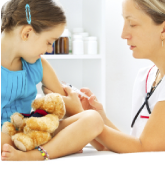
Could your child have an ear infection?
Posted April 28, 2015 | Immunity, kidsBy: Lisa Yang, ND
More than 80% of children in the United states have at least one episode of acute ear infection by 3 years of age. In 2000, there were 16 million visits to physicians for acute ear infections in children. And it is among the most common diseases that lead to treatment with antibiotics. (1)
Anatomy
Ear infections are generally characterized as an infection and inflammation of the middle ear. The ear is divided into three parts: the external ear canal, the middle ear where infections can occur and the inner ear contains nerves and structures that play a large role in balance and hearing. The middle ear contains small bones that conduct the vibrations of the ear drum to the brain as well as the back of the nose connected via the eustachian tube. The eustachian tube opens and closes and helps to equalize the pressure across the tympanic membrane that is optimal for hearing, protects the middle ear from infection and clearance of middle ear secretions. Anatomically as infants and young children, the tube is much shorter, wider and more horizontal than in adults which makes the migration of bacteria from the nose and back of the throat not the middle ear space.
Signs and symptoms to watch out for:
- Cold symptoms: it is possible that your child may have a clear runny nose that will turn to yellow or green before an ear infection.
Complaining of:
- Ear pain, batting or tugging on ears.
- Hearing muffled words
- Possible tooth pain
There may or may not be:
- The presence of a fever
- Increased agitation and fussiness
- Night waking.
Contributing factors:
The causes of ear infections are most commonly due to underlying viral infection (ie. rhinovirus, RSV, or influenza). In addition, they can be caused by bacterial infections and underlying allergies. Many children with recurrent ear infections may have food or environmental allergies that can increase overall inflammation and fluid accumulation. If you are concerned about this talk to your physician about testing options! Other risk factors include exposure to tobacco smoke, long day care hours, pacifier use, and reflux. If your child has chronic ear infections, exploring preventative measures is important.
Guidelines for treatment from the American Academy of Pediatrics have changed over the years. Antibiotics are the mainstay for children younger than 6 months to 2 years of age with significant infection. For older children there are studies that support close observation as an acceptable management option in low risk children. This is where naturopathic treatments are important in fighting infection and supporting the immune system.
Naturopathic treatment may include, but are not limited to:
- Garlic-mullein ear drops- garlic and mullein are both very antimicrobial, mullein has properties that reduce inflammation.
- Thyme/eucalyptus essential oils mixed in a carrier oil like olive oil and used as a vapor rub behind the ear and down the chin. These essential oils have antimicrobial properties.
- Contrast hydrotherapy, lymphatic and eustachian tube drainage massage will help to bring blood flow to the area and help drain excess fluid build up in the inner ear
Immune support:
- N-Acetyl-Cysteine- precursor to glutathione, acts as an antioxidant, decrease mucus plugs, and can also be nebulized.
- Fruit anthocyanin- high in bioflavonoids and antioxidants
- Probiotics
If you suspect your child to have an ear infection, it is important to consult with your doctor to properly manage care.

Spring Angries? Allergies, Histamine and Behaviors
Posted March 25, 2015 | Allergies, Immunity, kidsOne of the questions that I get asked quite a bit is, “ Why does my child seem to get so much worse during the Spring?” And, by worse, it is generally meant, an increase in aggression, hyperactivity, and general poor regulation. I have reflected quite a bit as to what some of the underlying mechanism are that contribute to a seasonal distribution of symptoms.
One simple answer is that if your child is prone to seasonal allergies they just feel physically worse in their reactive season; spring/ summer for pollen and trees and fall/ winter for molds. Here is a child that on top of their usual constellation of behavioral symptoms they are now feeling: fatigued, stuffy, itchy and probably more irritable. Anyone that is experiencing this can be less regulated, but compound that onto someone that is already dealing with sensory overload and mood or behavior challenges and it is a recipe for disaster. Typical behavioral presentations for children that are affected by seasonal allergies include and increase in restlessness, irritability, impulsivity and a potentially an increase in violent behaviors.
Looking a little closer at potential mechanism we need to look at the action of Histamine. This versatile neuropeptide is secreted and regulated by multiple cells in the body; like mast cells and basophils, which are two particular immune cells. These cells are all over the body but are particularly numerous in the upper respiratory systems, blood vessels and the brain. Interestingly they are also present in the gut! In addition, stressors on the body like hypoglycemia and dehydration also increase histamine secretion.
In the peripheral body, histamine is responsible for signaling regarding tissue injury, blood vessel permeability, inflammation, and itch modulation. For example when you get a mosquito bite and you get a swollen bump that itches; this illustrates the signaling to the immune system, the encapsulation of the toxin, the inflammation and the itching! Some people have much stronger reactions than others, indicating an exaggerated histamine response.
In the gut histamine plays a role in hydrochloric acid secretion, gut microflora, and inflammation. Histamine is released by special cells that get turned on or off depending on their environment. Certain bacteria can cause also an increase in histamine production. In addition, stressors on the body like hypoglycemia and dehydration also increase histamine secretion. While this can be good too much of a good thing can cause problems like reflux, imbalanced flora, food allergies and leaky gut.
Histamine regulation in the brain is involved in many central nervous system functions such as cognition, emotion, learning and memory as well as arousal (wakefulness and attention); temperature regulation, activation of the sympathetic nervous system and suppression of eating/ appetite. This can be appreciated as changes in sleep, mood, memory and eating habits. Histamine also has the potential to increase blood brain barrier permeability, which can increase the transport of unwanted substances into the brain. Interestingly, in the brain histamine can also affect motion; high levels can induce changes in postural tone and vestibular function.
Like many biologically active compounds too much or too little can be problematic. Several animal studies indicate that histamine dysregulation (either too high or too low) can also be contributing factors to promoting anxiety. Other studies indicate disruption of histamine regulation can lead to mood/ behavior issues, neuroinflammation, eating and movement disorders, as well as sleeping issues, food allergies and autoimmunity. For example: when histamine levels get too low we can become paranoid and suspicious, experience ringing in the ears, fatigue easily, anxiety, irritability, we may see or hear things abnormally. Conversely, when brain histamine levels get too high we tend towards hyperactivity, compulsive behavior, anxiety, and depression.
What to do?
Elevated Histamine:
Avoiding additional sources:
Foods: some foods that are high in histamine include: bananas, citrus fruits, berries such as strawberry and raspberry, tomatoes, several types of tree fruits such as apricot, cherry and plums, and some vegetables, particularly eggplant (aubergine), and pumpkin
Also- unfortunately fermented foods tend to concentrate histamine- but this may be one of the reasons why you or your child has some difficulty adding in fermented foods to your diet-
Dysbiosis – some bacteria is able to convert the precursor histidine to histamine contributing to gut inflammation, permeability and food allergies
Food additives: tartrazine
Helping with processing:
- Vitamin C
- Inositol
- Phosphatidyl Choline
- B-vitamins
- Calcium and magnesium
Methylation: Very interestingly, Histamine requires Methylation to be broken down! As many of you know this is a big problem for lots of our kiddos!
Low Histamine:
These people tend to be overmethylators- so some of the methylation support will make them go crazy-
Addition of high histamine foods
Histidine- a precursor for histamine
zinc
If you have questions or want to discuss dosages that are appropriate for your child, please schedule an appointment!
Hass HL, Sergeeva OA, Selbach O, “Histamine in the nervous system” Physiol Rev 2008 Jul;88(3):1183-241.








